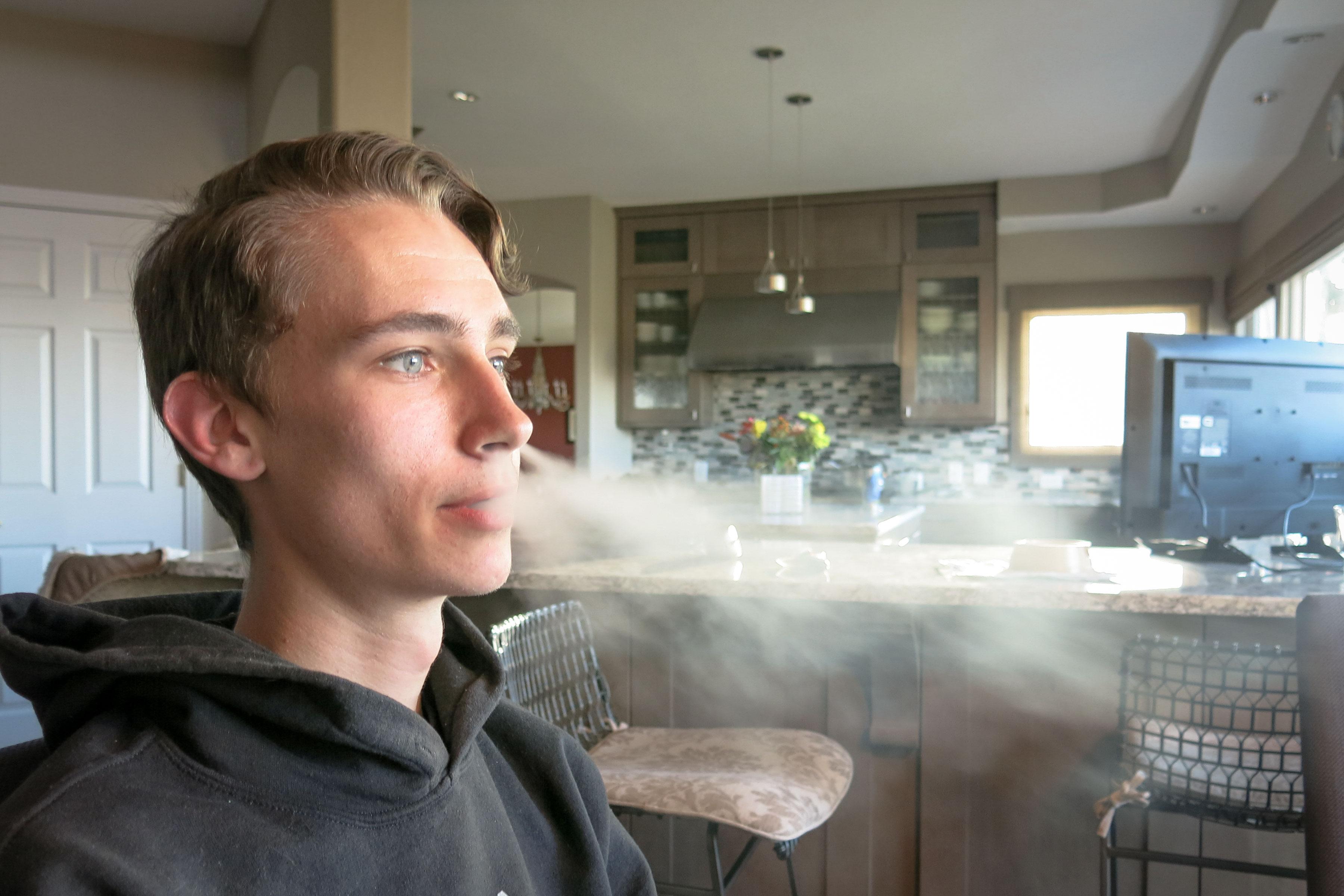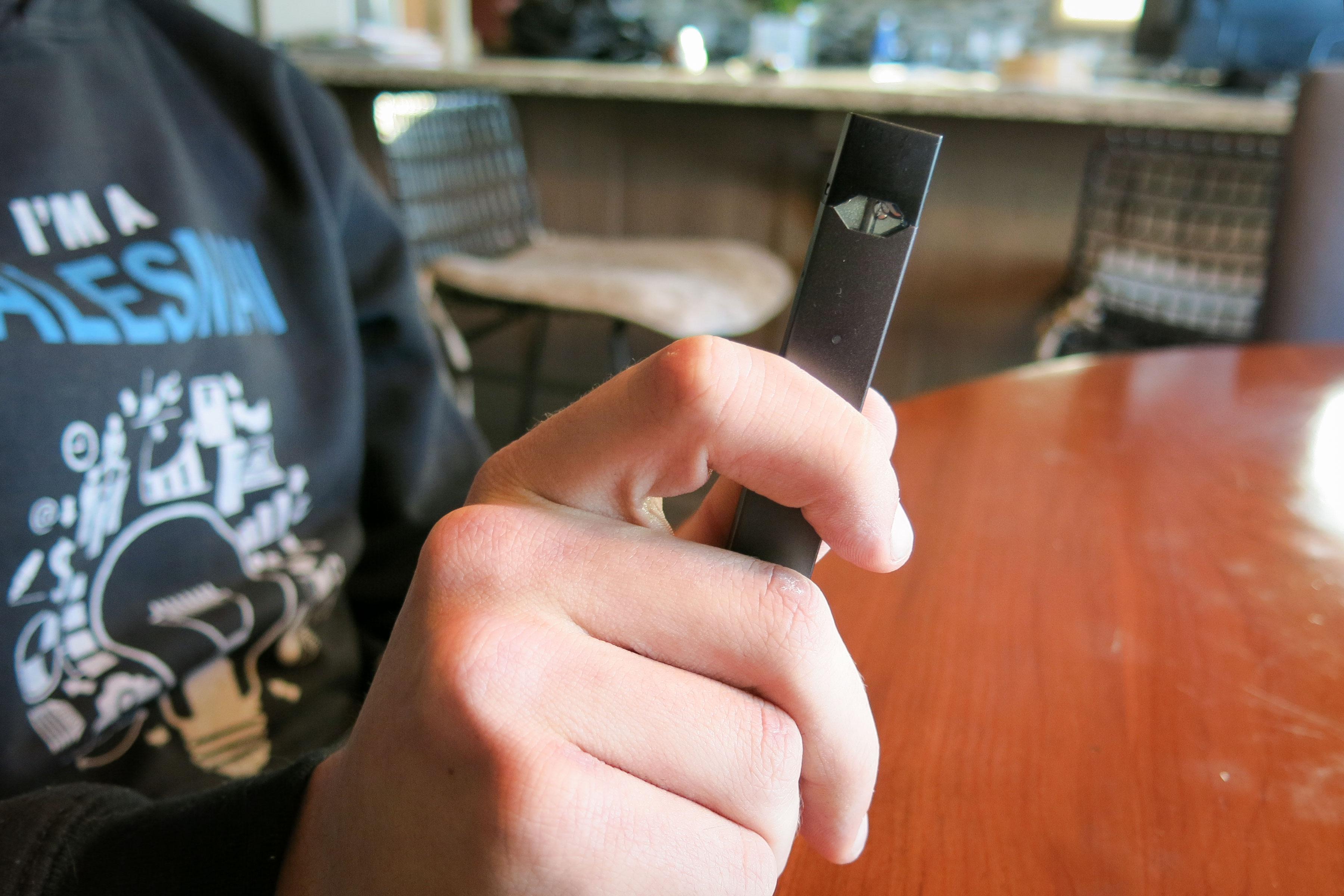

Vaping has taken off with young people, especially with the most popular brand, Juul. Its devices are tiny, and look like a pen or flash drive. When someone vapes there’s no fire, ash or smoky odor — instead, the devices heat up and vaporize a liquid or solid.
Federal agencies recently launched a wave of crackdowns against retailers that sell the Juul brand e-cigarettes to minors. Public health officials worry it could be an emerging disaster, reversing years of declines in smoking.
“Believe it,” said 21-year-old Julien Lavandier.
“It’s a habit for me, you know, all the time when I set down my schoolwork to do homework, take a rip of the Juul,” Lavandier said. “When I get in my car, take a rip of the Juul.”
Lavandier, a junior at Colorado State University, started vaping when he was a 16-year-old sophomore at Regis Jesuit High School in Aurora. He’d go to parties where it was common to smoke an e-cigarette.
“At first it was a lot of, you know, chasing flavors, or doing smoke tricks and that was really what impressed me,” he said. “I thought, you know, this is cool, this looks like something fun.”

Students at his high school “smoked” in class without teachers knowing. He estimates a quarter of his classmates were habitual e-cigarette users. Lavandier started vaping regularly and later began smoking traditional cigarettes. When Juul arrived on the market, he took that up too, and found it habit-forming. More than marijuana or alcohol.
“It’s impossible to to let go once you started using,” Lavandier said. “I’ll tell you after even an hour and a half or two I am chomping at the bit to find my Juul.”
Stores aren’t supposed to sell e-cigarettes to minors, but Lavandier has been buying them for years and was never once carded. The FDA has also asked the firm behind Juul for documents to see if it’s intentionally marketing to underage teens.
The company has online testimonials and a community around their product. In one video, a woman in her 30s named Lauren said she’s constantly “encouraging people to use this and not smoke your cigarettes.”
Representatives from Juul Labs declined an interview. A statement said its product offers a “true alternative to adult smokers, not anyone else, not minors.” Other companies that make e-liquids say their products are also not for minors. These companies do offer a rainbow of flavors, however, like cotton candy, caramel, cherry, Smurf sauce and cookies and milk.
“If it tastes good and a kid might get their hands on it, that’s not our goal” said Jameson Rodgers, the VP of business development for California-based e-cigarette and vaping products producer NEwhere Inc.
As part of the crackdown on marketing to minors, the FDA targeted the company’s e-liquid: One Mad Hit Juice Box. Rodgers said the company pulled it from distribution in 2017 and pointed out that their products comply with federal law and it’s up to retailers and distributors to not sell to minors.
“Also, I feel like some of the responsibility has to fall on some of the parents of any kid that’s deciding to walk into an adult store, whether that’s a liquor or a tobacco store,” Rodgers said.
The head of Colorado’s health department, Dr. Larry Wolk, finds it hard to believe industry claims that they aren’t marketing to kids.
“I have to call BS on that because the flavors are cotton candy, Frutti Tutti and they have cartoon characters on their labels and you can mix flavors and strengths,” Wolk said. “It’s really appealing to kids whether or not they are intentionally marketing to kids. What they are doing is appealing to kids.”
Wolk also pointed to research about youth vaping leading to traditional smoking. A January report from the National Academy of Sciences, Engineering and Medicine makes that conclusion: “Among youth — who use e-cigarettes at higher rates than adults do — there is substantial evidence that e-cigarette use increases the risk of transitioning to smoking conventional cigarettes.”

One of the benefits of e-cigarettes, according to the industry, is that they can help people quit traditional smoking. When it comes to the habit, the advice from Ray Story, the founder and CEO of the Tobacco Vapor Electronic Cigarette Association is “don’t start at all.”
“But if you’re going to smoke or do e-cigarettes, then certainly take an e-cigarette because it’s vastly less harmful, if you consider both of them contain nicotine and both of them are addictive,” Story continued. “It’s vastly less harmful than conventional tobacco.”
Deb Liptzin, a pediatric pulmonologist at Children’s Hospital Colorado sees e-cigarettes as the “new way to get kids addicted to nicotine.” There’s been scant e-cigarette research, she said, including on Juul and the ingredients in the e-liquids used in the devices.
“They specifically use nicotine salts,” Liptzin said. “We have no research that I could find on nicotine salts that are inhaled, because it’s so new.”
Data from the 2015 Healthy Kids Colorado Survey found nearly half of Colorado high schoolers reported that they’ve vaped. One in four said they had used an e-cigarette in the last month. That’s three times the rate of traditional cigarettes, and has raised concerns among public health officials.
“We don’t want the tobacco industry addicting another generation,” said Natalya Verscheure, the state’s tobacco program manager. She called smoking of e-cigarettes “a gateway to picking up conventional smoking.”
“The Juul has definitely been a game changer,” said Jen Bolcoa, a health education coordinator with Jefferson County Public Schools. Bolcoa said a tiny pod of e-liquid in a Juul has the equivalent nicotine of 20 cigarettes, an entire pack. Most educators, parents and students “don’t realize how much nicotine is in there, or that there’s even any nicotine,” she said. “That’s what the research tells us.”

Bolcoa’s job is to help implement Jeffco’s Tobacco Free Schools Policy; she works with students as part of the Breathe Easy Team. Wheat Ridge High senior Gabriella Cordova, a member of the team, said that she felt that “kids in schools don’t have enough knowledge about what they’re putting into their system.”
There’s another wave of products, Cordova said, that are growing in popularity, like nicotine pouches called Zyn, which are used like chewing tobacco. Like Juuls, they’re “super easy to hide, accessible,” she said.
The Breathe Easy Team is educating students, parents and administrators about the larger risks of tobacco use and Juuls. An educational video posted it on Facebook tells viewers that “Juuls and other e-products are disguised to look like pens, flash drives.” Their video competes with others posted by teens on social media sites like Instagram or Snapchat. On YouTube, there’s a video called the Juul Challenge. Two guys sit in the smoke-filled front seat of a car, competing, pulling on Juuls.
“Cheers guys. Let’s see how many hits I can do? You got five,” one of video performers said. “How many hits can you do,? Write in the comments.”
That video had more than 145,000 views in three weeks. Teresa Kenison, a senior at Wheat Ridge High and Breathe Easy Team volunteer, said social media helps drive the trend. She’s seen frequent use in classrooms, bathrooms, and parking lots. All sorts of students are using e-cigarettes and Juuls, from those in AP classes to athletes.
“It’s really everywhere,” she said. “Students are getting hooked.”

And she’s noticed older kids making runs to the convenience store for younger ones.
“‘Can I give you this money so you can get me a pod or will you go buy me a Juul?’” said Kenison. “It’s kind of like it’s drug world if you think about it, because that’s how dealers are doing their business and that kind of thing.”
College student Julien Lavandier can attest to the deceptive power of e-cigarettes. After he began using Juuls, he began sharing them with his mother Patricia, telling her that they were “less dangerous” than cigarettes and could help her stop smoking altogether. She’d smoked off and on for many years and had a hard time quitting.
“So I tried e-cigarettes a year ago, after a week I got used to it,” Patricia said. She later tried to give up Juuls too, but “guess what? It was even more difficult to quit the e-cigarette than to quit the real cigarette.”
Lavandier said he’s now hooked on both cigarettes and e-cigarettes. He’s tried to quit, but now can’t go three days without using a Juul. On a typical day, he’ll take upwards of 300 puffs.
“So my biggest concern is, you know, right now I’m puffing, puffing, happy, worry-free, and then in 20 years I’ll have to explain to my kids why I’ve developed popcorn lung or some new form of lung cancer,” Lavandier said. “Because I didn’t know what the risks were of e-cigarettes. It terrifies me.”
Editor's Note: Both the written and radio story have been updated to correctly identify Ray Story. Earlier versions misidentified the name of the CEO of the Tobacco Vapor Electronic Cigarette Association as Ray Short.








